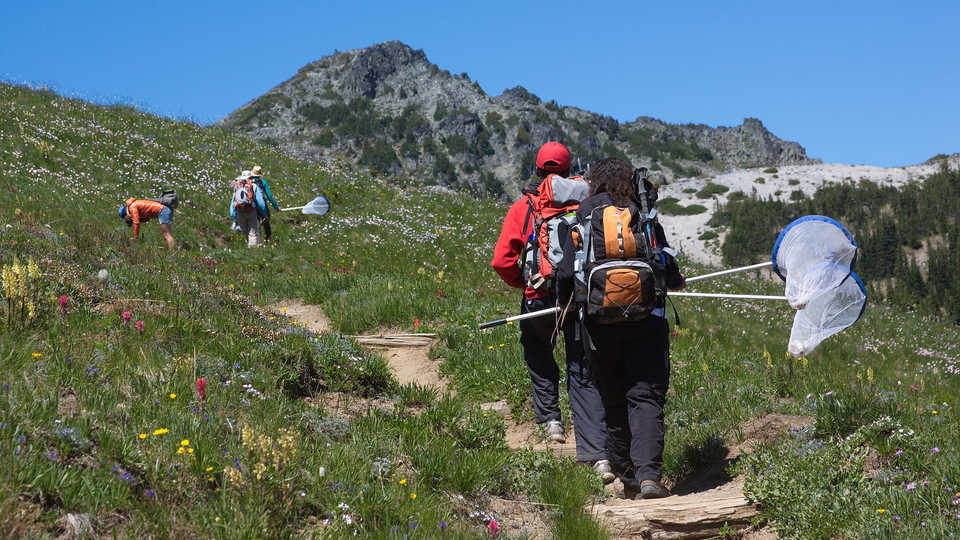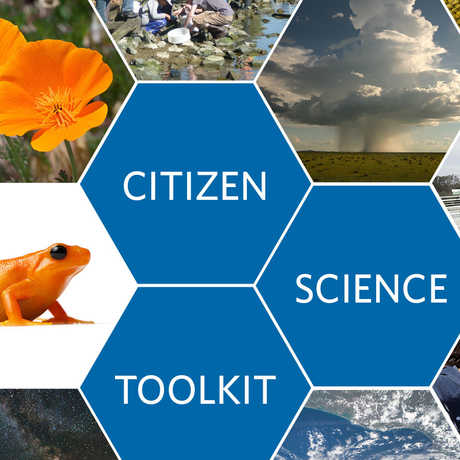
©Mount Rainier National Park
Using simple tools and technology, develop and carry out an original scientific investigation about biodiversity near your school. Use iNaturalist to conduct a biological survey, get help with species identification, and connect with a global network of naturalists. Then analyze your data, draw conclusions, and share your findings to inspire environmental stewardship in your community.
Activities Content Standards
Prepare to Explore NGSS:Science Practices
Embark on Your First Expedition NGSS: Crosscutting Concepts
Notice Details and Ask Questions Common Core: English Language Arts
Embark on Your Second Expedition
Construct a Scientific Argument
- Computer or device with internet access
- Camera
- Science Journal or Notebook
All expeditions take preparation. Before your students get started, take a moment to become familiar with the iNaturalist mobile app and website.
- Read through the tutorials and the Teacher’s Guide.
- Create your own account.
- Once your account is set up and you are logged in, follow the instructions to designate your study site (schoolyard, garden, etc.) as a Place. This will allow students to track all the data that has ever been collected in that location.
- If you like, you can also follow these instructions to set up (or help your students set up) a Project, which allows the user to create original fields in order to record supplementary data.
- Scroll through any data that already exist from that area. Which species have you seen before? Which are unfamiliar to you? Who collected those data?
- Once you are comfortable with iNaturalist, create an account for you class or an account for each individual student.
- Allow the students to spread out and explore the organisms that live within the study site. Whether your site is lush with greenery or covered with asphalt, you may be surprised at the diversity of life that exists outside your classroom.
- Have your students create a preliminary inventory by using a camera or mobile device to take photos of individual organisms.
- Divide up responsibilities so that everyone has a chance to take photos, sync to iNaturalist, ID species, and complete your online entries.
- Use the online tutorials to walk you through this process.
- Now that your students have a sense of their local biodiversity, have your students look through their data and compare their study site to a nature preserve. Have them answer the fallowing questions in their science notebook or field journal:
- What kinds of organisms are there a lot of near your school?
- What is rare? Why do you think that is?
- How did the organisms near your school get to be there?
- What do they need to survive?
- Have your students take notes on examples of living things interacting with each other, as well as living things interacting with nonliving things.
- Ask your students:
- Does anything seem strange, confusing, or interesting to you about what lives in your environment?
- What questions do you have?
- Make sure your students are keeping a running log of their ideas.
- Divide your students into teams of two or three.
- Within the team, have the students brainstorm keywords and search terms that would help you find information about environmental issues in your community.
- Then have the students use those phrases to search the web for news articles, video clips, blogs, or other media sources to see what’s been published.
- In addition to major news outlets, check publications from local nature centers, science museums, and environmental organizations.
- Make sure your students bookmark their sources so that they can find them again later.
- Have your students answer the following questions:
- Have your students try to connect what they have learned from the news with what they noticed around your school. What topics seem to be good leads?
- Have your students work in teams and brainstorm 3-5 people they think could help them better understand local environmental issues. Remember to consider nearby nature centers, science museums, and environmental organizations.
- Your students should generate a list of 5-7 questions for an interview. Remind your students to:
- Aim their questions to spark a discussion by using open ended questions, rather than questions that could be answered with one word.
- Wherever possible, ask for specific examples.
- Help your students draft a friendly and welcoming opening statement that will help them introduce themselves and their project to the interviewee. This will be their opening statement when addressing their contacts by phone, email, or in person.
- Make sure your students designate responsibilities among their teammates. Who will ask the questions? Who will take notes? Make sure they have a clear plan before the interviews. Consider having the students rotate jobs from one interview to the next.
- Allow your students to reach out to their contacts. Then, with their tools and questions in hand, begin the interview. Remind your students to:
- Try to have an interesting conversation, rather than a question and answer session.
- Listen carefully to the responses and ask follow up questions, even if you didn’t think of them in advance.
- Be sure to keep careful notes.
Using what your students have learned from their observations, background research, and local experts, have your students choose a topic they'd like to know more about. From there, guide your students to develop a research question they believe they could answer by studying the biodiversity of in their field site. Make sure your students are recording their research question in their science notebook or field journal.
Help you students know what information they will need to answer their research question. Ask them the fallowing questions:
- What information would you need to answer your research question?
- Will the existing data and your inventory be enough? Or will you need to more?
- Remember to also consider any contextual factors that could influence your data.
For example, if your students want to know how schoolyard trash influences the diversity of birds at your school, they’ll definitely want to record the amount of trash and the types of birds present on a regular basis, but they might also want to know the time of day, temperature, weather conditions, noise, or anything else that could influence them.
Give time to have your students think back to their research question. What information did they think would help answer it?
Now have your students examine their results to see what they found. Ask the fallowing questions to help them analyze their results:
- Does the data show a clear picture?
- Are there outstanding unknowns?
- What sources of error might have prevented you from collecting sufficient data?
Allow your students to talk out their ideas with their teammate and begin to draw conclusions.
Using the Claim-Evidence-Reasoning model, have your students construct a scientific argument based on research question.
- A claim is a statement or conclusion that answers the original question/problem.
- Evidence is the scientific data that supports your claim. Remember that the data need to be relevant, appropriate, and you need to have enough to convince someone who is skeptical.
- Reasoning is a justification that connects the evidence to the claim. It shows why the data you offer count as evidence by addressing appropriate scientific principles.
Spread the Word
Ask your students:
- What is the most interesting or important thing you discovered from the data you collected and/or analyzed?
- Who in your community should know about it?
If your students are interested in sharing their findings, follow the steps in Modern Media Blitz to share their stories to create a social media campaign to share their results.
- Asking questions
- Planning and carrying out investigations
- Analyzing and interpreting data
- Using mathematics and computational thinking
- Constructing explanations
- Engaging in argument from evidence
- Obtaining, evaluating, and communicating information
- Patterns.Observed patterns of forms and events guide organization and classification, and they prompt questions about relationships and the factors that influence them.
- Structure and function. The way in which an object or living thing is shaped and its substructure determine many of its properties and functions.
Common Core: English Language Arts Anchor Standards
- CCSS.ELA-LITERACY.CCRA.W.4 Produce clear and coherent writing in which the development, organization, and style are appropriate to task, purpose, and audience.
- CCSS.ELA-LITERACY.CCRA.W.5 Develop and strengthen writing as needed by planning, revising, editing, rewriting, or trying a new approach.
- CCSS.ELA-LITERACY.CCRA.W.6 Use technology, including the Internet, to produce and publish writing and to interact and collaborate with others.
- CCSS.ELA-Literacy.CCRA.W.7 Conduct short as well as more sustained research projects based on focused questions, demonstrating understanding of the subject under investigation.
- CCSS.ELA-LITERACY.CCRA.L.1 Demonstrate command of the conventions of standard English grammar and usage when writing or speaking.
- CCSS.ELA-LITERACY.CCRA.L.2 Demonstrate command of the conventions of standard English capitalization, punctuation, and spelling when writing.

Check out our Citizen Science Toolkit, designed to help educators integrate citizen science projects into classroom curricula or afterschool programming.
It contains resources—including lessons, readings, and worksheets—to help communicate the value of citizen science to students and cultivate their sense of empowerment and impact when performing science investigations.